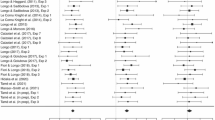Abstract
An introspective measure of tactile tendency was developed for college-age students. Personality correlates of high and low tactile tendencies explain some individual differences in the use of tactile communication.
Similar content being viewed by others
References
Anderson, P.A. & Leibowitz, K. The development and nature of the construct touch avoidance.Environmental psychology and nonverbal behavior 1978,3 89–105.
Berryhill, N. The influence of age, sex, family size, and community size on attitude toward tactile communication. Unpublished master's thesis, Texas Tech University, 1982.
Cattell, R.B., Eber, H.W., & Tatsuoka, M.M.Handbook for the Sixteen Personality Factor Questionnaire (16PF). Champaign, III.: Institute for Personality and Ability Testing, 1970.
Clevenger, T. A synthesis of experimental research, in stage fright.Quarterly Journal of Speech 1959,45 134–145.
Frank, L.K. Tactile communication.Genetic Psychology Monographs 1957,56 209–255.
Henley, N.Body politics. Englewood Cliffs: Prentice-Hall, 1977.
Institute for Personality and Ability Testing.Tabular Supplement No. 1 to the 16PF Handbook. Champaign: Institute, 1970.
Jourard, S. An exploratory study of body accessibility.British Journal of Social Clinical Psychology 1966,5 221–231.
Leibowitz, K., & Anderson, P. The development and nature of the construct touch avoidance. In B.W. Morse & L.A. Phelps (eds.),Interpersonal communication: A Relational Perspective. Minneapolis: Burgess, 1980.
McCrosky, J.C. Oral communication apprehension: A summary of recent theory and research.Human Communication Research 1977,4 78–96.
Montague, A.Touching: The Human Significance of the Skin New York: Columbia University Press, 1971.
Morris, D.Intimate Behavior New York: Random House, 1971.
Nie, N.H.,et al., Statistical Package for the Social Sciences New York: McGraw-Hill Book Co., 1970.
Prescott, J.Behavior Today May 15, 1978,9 5–7.
Scheflen, A.Body Language and the Social Order Englewood Cliffs: Prentice-Hall, 1972.
Silverman, A.R., Pressman, R., & Bartel, T. Self esteem and tactile communication.Journal of Humanistic Psychology 1973,13 76.
Stembridge, D.A.An exploratory study of tactual behavior. Unpublished doctoral dissertation, University of Houston, 1973.
Walker, D.A dyadic interaction model for nonverbal touching behavior in encounter groups. Unpublished doctoral dissertation, University of Connecticut, 1971.
Author information
Authors and Affiliations
Rights and permissions
About this article
Cite this article
Deethardt, J.F., Hines, D.G. Tactile communication and personality differences. J Nonverbal Behav 8, 143–156 (1983). https://doi.org/10.1007/BF00987000
Issue Date:
DOI: https://doi.org/10.1007/BF00987000




